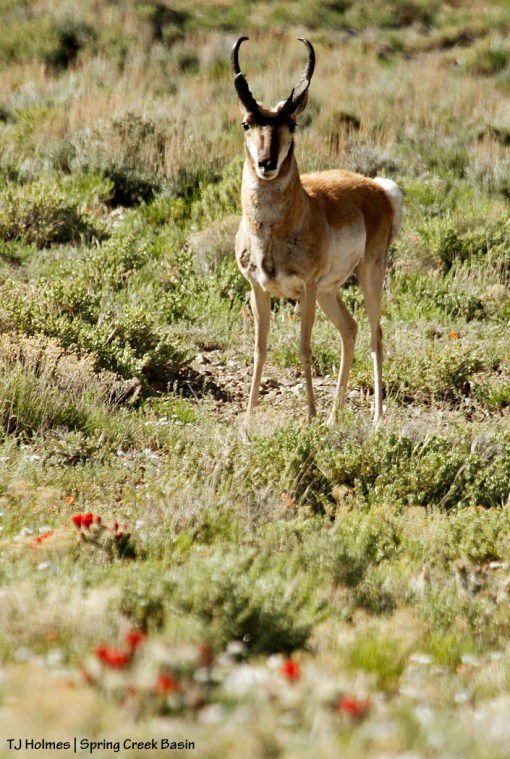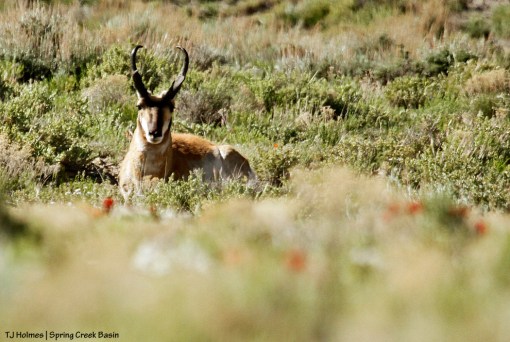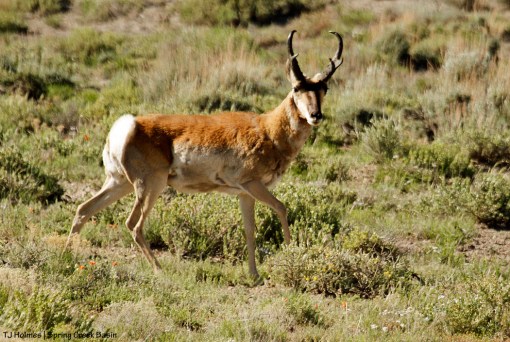I was just walking along when …

This pronghorn buck was napping when I crested a little hill and saw him. He stood up, and I stood still. Apparently, he didn’t detect a threat, so he laid back down.

Note: All the little red bits are blooms of claret cup cacti, which seem particularly spectacular – and prolific – this year.

These photos all are significantly cropped. Pronghorns are much warier of intrusions by two-legged intruders than the mustangs. 🙂
Interesting trivia:
They’re the fastest North American land mammal – actually, the fastest in the entire Western Hemisphere, according to Wikipedia.
Wyomingites call pronghorns “speed goats.”
Pronghorns are not antelope, which is why it’s correct to call them pronghorns (pronghorn/pronghorns for plural animals? that’s one I’m not sure about).
Pronghorns prefer crawling under fences to jumping over them, which is why wildlife-friendly fencing that takes elk calves and deer fawns into consideration also considers this knowledge about pronghorn behavior – stringing the lowest wire strand at least 18 inches off the ground.
Pronghorns aren’t currently hunted in Disappointment Valley because their population is low (likely *because of* previous hunting). They seem to be working toward recovery because while they’re infrequently seen, they ARE seen.
Visit Wikipedia for more information about these cool mammals.
A fantastic book (thanks, David Temple!) is Built for Speed: A Year in the Life of Pronghorn.
Thanks for the information. So, what are antelopes then?
Pronghorns aren’t antelope in the true, biologic sense – as it has to do with antelope species in Africa, say. The pronghorn evolved in North America – like the horse! (More detailed than that, and I’d need a biologist to explain it! :)) It’s like bison and buffalo; bison is the true name for American bison because they aren’t buffalo in relation to species found other than in North America.
TJ, not surprised by his lack of concern about your motives – your wild neighbors know you and your respect for them!! Thanks for sharing
Thank YOU for enjoying!
I was surprised to learn that they too shed their antlers annually. Beautiful photos TJ! Thanks for sharing.
Just the outer sheath, I think, which is why their horns are still referred to as horns, not antlers. 🙂 Pronghorn(s) are confusing critters!
Wonderful! He laid back down!
I am always so happy when on a rare occasion one will not run away from me!
I’m glad they are trying to bring them back. 🙂
And those cactus blooms are rich! Yay!
Me, too (about allowing them to recover). They’re such an amazing animal – and unique. 🙂
Great pictures of the resident pronghorns, TJ! The three we saw Wednesday hung around us for two hours without much concern. Hopefully there isn’t a hunting season for them in the Basin.
There’s no hunting season for them here (though that could change?). I think you have to go to the Front Range (in Colorado, at least) to find hunting of pronghorns. Hunting of elk and deer – with the right season and permit/license – is permitted in Spring Creek Basin and Disappointment Valley – and most everywhere in Colorado.
Good stuff!! 🙂
Thanks. They’re pretty cool, and I was glad this guy was so accommodating!